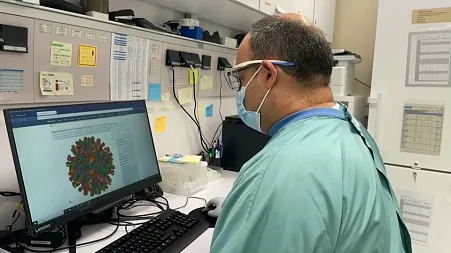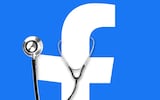When Dr. Jennifer began bleeding and cramping set in, she had two priorities: get to the hospital and complete her clinical notes. Not necessarily in that order. Jennifer, who requested she only be identified by first name, was five months into her pregnancy. As a family medicine physician, she recognized the symptoms of preterm labor—and if any of her patients had been in her shoes, she would have instructed them to call an ambulance immediately.
But it was only afternoon, and Jennifer still had patients to see. She continued her scheduled visits, then stood at the counter, pushing through the pain and panic, to finish the accompanying notes. "I had to finish my work before I left to go to the hospital," Jennifer said. "It's crazy, but it's just what you do."
When Jennifer finally drove herself—and her laptop—to the hospital, her doctor issued an ultimatum: Keep working or keep the baby. Jennifer chose six weeks of bed rest and, for the first time since before her residency, tasted stillness.
During her 60-hour workweeks, she usually saw 25 patients a day with three patients waiting in exam rooms at any given time, spending 10 or 15 minutes with each. She didn't stop for lunch and rarely took bathroom breaks. "I was really efficient. I didn't usually run behind," Jennifer said. "Except I couldn't finish my patient notes—because I couldn't work on notes while I had two other patients waiting for me."
On typical workdays, Jennifer would get home around 6:30 p.m. and then spend an hour or two catching up on notes. The work often trickled into the weekend, typically biting four to eight hours out of her Saturday. "Over time, you think, 'This isn't how I wanted to practice medicine.' I want to sit down and have a conversation and really take care of people," Jennifer said. "I realized there's more to life than working like this."
After giving birth to a healthy son and returning from a six-week maternity leave, Jennifer pondered how she could stop working for a "big" medical group that didn't allow for the type of care she wanted to give. About a year later, she resigned.
There are a lot of other doctors who have come to that conclusion. More than 71,300 physicians in the U.S. left their jobs between 2021 and 2022, according to data analytics firm Definitive Healthcare, or 6 percent of the total physician workforce—almost double the rate prior to the pandemic. By comparison, that same year, U.S. medical schools graduated 21,051 new doctors, according to the Association of American Medical Colleges, AAMC.
A poll by the Medical Group Management Association found that in 2021, 33 percent of all medical practices said at least one of their physicians had retired early or left because of "burnout," defined in the medical journal World Psychiatry as a "psychological syndrome" resulting from "chronic interpersonal stressors on the job." Last year, according to the American Medical Association, nearly half of doctors reported at least one symptom of burnout: exhaustion, cynicism, detachment or a sense of ineffectiveness.
Although the condition is not new, it peaked alongside the strains put on the health care system by COVID-19. There are indications that patient care is being affected. Several studies have linked doctor burnout to major medical errors. And the physicians who have given up the profession have left a crisis-sized hole, creating even more stress for those who remain.
But for the past two years, buzz about a possible solution has been building. Generative AI, the technology behind ChatGPT, may not replace your doctor anytime soon, but there is a lot of hope that it can make your doctor's job easier by reducing time spent on the sort of charts Jennifer was working on while facing preterm labor.
Documentation tasks like replying to patient messages, filing clinical reports and dealing with insurance matters currently take up nearly half of doctors' workdays. If AI did this work instead, it could, theoretically, give back physicians some much-needed time. "That's a huge potential, which everyone recognizes," said Parminder Bhatia, chief AI officer of GE HealthCare. McKinsey & Company estimates that generative AI could yield $1 trillion worth of improvement in the health care industry, in part by "automating tedious and error-prone operational work."
No Appointments Available
Preventing doctors from burning out and quitting the field is especially critical as the U.S. health care system faces some daunting demographic pressures. In 2023, the Census Bureau reported that Americans aged 65 or older will outnumber children by 2030. Currently, about one in six Americans are age 65 or older; by 2060, it will be nearly one in four. More older people will need more doctors, but the AAMC estimates that by 2033 the U.S. will be short by up to 139,000 physicians. "You can't run a health care system without the clinicians," noted Microsoft chief medical officer and vice president of healthcare Dr. David Rhew.
Meanwhile, wait times will get longer and patients will grow increasingly impatient. Health care is essentially a service industry. Innovations like telemedicine don't change the fundamentals: A doctor must still conduct the visit. "AI is not going to solve the physician shortages across the country," said Garrett Adams, vice president of research and development at medical software provider Epic. "We can help them do more with less, but we can't solve the fact that there is less."
When Jennifer pictures herself charting while facing possible preterm labor, the first word that comes to mind is "proud," she said. "But then I also feel kind of disappointed because I know there's a better way."
Cutting Through the Data
Health systems have long been aware of the growing administrative burdens on doctors. The key culprit is the electronic health record, an innovation that started mainly as a way for hospitals to track patient billing and appointment scheduling. But, in the 1990s, as computer technology improved and was widely adopted by medical practices, the EHR began to sprawl into a massive tome encompassing a person's entire medical history.
It is no coincidence that Epic, one of the largest EHR vendors, was named after literary "epics," heroic poems defined by their extreme length. A study from the University of Wisconsin found that one in five patients has an EHR the size of Herman Melville's Moby Dick, more than 206,000 words. "[Generative AI] is an opportunity to add a layer of simplicity on top of the Moby Dick-sized amount of information in a patient's chart," Adams said.
Epic has added dozens of AI functions to its software, said Seth Hain, the company's senior vice president of research and development. "[Epic's] focus with generative AI has been to help folks be more efficient," Hain said. One new tool summarizes those lengthy EHRs. Another function drafts replies to messages on MyChart, Epic's portal that allows patients to communicate with their doctors. More than 250 health systems are using the current tools, and over 100 new functions are in development.
Dr. Michael Hasselberg, chief digital health officer at UR Medicine in Rochester, New York, said there has been a 300 percent increase in messages through its patient portal over the past five years. Every message—including appointment scheduling and prescription refills—goes to a doctor. It isn't the most efficient use of time for people with medical degrees.
After a few days working with generative AI technology, Hasselberg's team was able to fine-tune a model that could reliably and accurately triage the messages. Now, he said, "the machine actually performs better than the human."
Another kind of AI-powered tool that is becoming popular is called an ambient scribe that records entire patient visits, creates a transcript and drafts the clinical notes. In UR Medicine's pilots, Hasselberg said doctors have saved "multiple hours a day" using various versions of these tools.
Other tools are showing promise. According to a survey by Microsoft, its DAX Copilot ambient scribe saves physicians an average of five minutes per visit with 70 percent saying the tool reduced burnout and fatigue. And the vast majority of patients, who must provide consent for their doctors to record their visit, said it made their clinician more personable, conversational and focused.
Ambient scribes can "liberate providers from their keyboards," said Dr. Daniel Yang, vice president of artificial intelligence and emerging technologies at Kaiser Permanente. "It allows them to refocus their attention from the computer screen back to the patient's face again. It makes care more human again."
But he is still cautious about making promises about how much AI will be able to deliver. Yang said he receives multiple pitches every day from AI developers and, as a practicing internal medicine physician himself, he worries that some are missing the mark. "I see a lot of mismatch between the needs and wants of providers and the technologies being developed for us," Yang said.
Manav Sevak, founder and CEO of AI company Memora Health, is working to tailor its tools to different specialists' workflows. An oncologist who needs to manage a patient's chemotherapy is going to need a different system than a gastroenterologist prepping someone for a colonoscopy.
"It's not as easy as you turn it on and every provider gets the same exact workflow," Sevak said. Memora uses natural language processing tools to spot patterns in individual doctors' work and understand where it can be automated. The process requires physicians' input on wording and flow and usually takes about an hour and a half for a doctor to complete.
Still Admin, Just Different
A common theme for many of the current crop of generative AI tools is that they change the nature of producing notes from writing to editing. While many physicians report that this makes the process less cognitively burdensome than starting from scratch, it doesn't always save time—especially if the quality of the AI text is poor.
A recent study from the University of California San Diego School of Medicine and Stanford University School of Medicine found that when doctors used generative AI to draft responses to patient messages, their replies were longer and more compassionate. But doctors were not spending less time writing. They would often keep the AI's added niceties like "have a nice vacation!" and "take care!" but then make substantial changes to the clinical content. Their surprising finding was that doctors spent nearly 22 percent more time reading messages when using AI. At the end of any of these processes, a doctor must still sign off on the clinical note—which means it's also up to the physician to double check whether the AI got it right.
These issues might make doctors feel inclined to wait until generative AI is a more mature technology. But that's risky, too. "If doctors don't pay attention now, technology will be done to them," said Nigam Shah, chief data scientist at Stanford Health Care. The last time doctors "sat out technology," he added, they got the time-sucking EHR. "Not every doctor needs to be involved, but every health system, every physician group needs to have a few people who are paying attention to the manner in which this technology is being developed, evaluated and used."
Doctors' Moral Injury
When Newsweek asked burned-out physicians what worried them most about AI, the most common doubt wasn't about the technology itself, but rather about how their employers would use it.
On paper, the two goals of AI—improving efficiency and reducing doctor burnout—appear to complement each other; if doctors finish their administrative tasks more quickly, they can spend more time with patients, then go home and unwind after their shift. Practicing medicine will feel less draining and more connective.
But some doctors see a paradox. American health systems are under pressure not just from provider staff shortages, but also low reimbursement rates and rising costs. Profit margins are slim. If AI frees up time for doctors, will that time really go back to them? Can they double the length of patient visits and spend their off-hours on something other than patient notes? Or will health systems see that saved time as a sign that doctors are ready to take on even more work? Suppose doctors are able to take on more patients because AI reduces time spent on some tasks. More patients will still inevitably create more lab results, more specialist referrals, more prescriptions refills, more cases to review, more informed clinical decisions to make.
None of the health systems we spoke to could yet say how doctor time-savings would be distributed. Generative AI technology is still so new that Kaiser is not certain how much time is being saved, according to Yang. Hasselberg said that while UR Medicine did not ask them to, some doctors have taken on more patients of their own accord. "Our intention with a lot of these ambient documentation tools was to focus on our workforce wellness and burnout," Hasselberg said. "With that being said, clinicians went into this field because they want to care for people."
Variations of this phrase are common in the pitches for new AI tools: "AI will handle the dirty work so doctors can focus on patient care." Yet, doctors told Newsweek that patient care can be the most devastating part of being a doctor. It's not uncommon for the life of a doctor to be compared to the life of a soldier. Service and sacrifice. Stoicism and stubborn pride. A disconnect between the mission you felt called to—caring, connective—and the system you fell into—industrial, impersonal.
"Moral injury is frequently mischaracterized. In combat veterans, it is diagnosed as post-traumatic stress; among physicians, it's portrayed as burnout," wrote Dr. Simon Talbot, an associate professor of surgery at Harvard Medical School, and Dr. Wendy Dean, senior medical officer at the Henry M. Jackson Foundation for the Advancement of Military Medicine, in an influential 2018 essay. "The moral injury of health care...is being unable to provide high-quality care and healing."
As the daughter of a pathologist and a psychiatrist, Oregon-based Dr. Pamela Wible spent her childhood between the mortuary and the state psychiatric hospital. She saw her parents care for people who had schizophrenia, who were homicidal, who were dead. She developed a "high tolerance for tragedy and trauma" and decided to go to medical school herself.
But as Wible's career progressed, she began to notice something: Doctors around her kept dying by suicide. Three physicians in her small town took their own lives within one year. Both of the men she dated in medical school later died by suicide at the prime of their careers, married with children. By the time Wible was in her early 40s, she had lost 10 colleagues to suicide. Back then, in 2012, you could google "Dr suicide" and get one page of results, she said. "I just thought it was odd. And what I thought was even more odd was that nobody wanted to research why." Wible stopped working in family medicine and now provides support to suicidal physicians. She has spoken with thousands of doctors, and the conversations rarely linger on paperwork. Often, they discuss a mismatch between their hopes and dreams and the reality of a career in the health care industry.
Every year, 300 to 400 doctors die by suicide, according to a decadelong literature review. Proportionally, that's more than double the incidence in the general population. "Unlike cigarettes that have a black box warning for lung cancer, there's no black box warning going into medical school that says, 'You may be at risk of suicide,'" Wible said.
Medicine is not practiced in a vacuum. Often the patients that doctors are trying to heal are suffering from societal issues—people who cannot afford $50 co-pays, children in unstable homes who can't keep medicine refrigerated—that they feel powerless to solve. "We're the social safety net for the country as well, where people go when they're homeless, wounded, having heart attacks," Wible said. "We don't have the emotional support that we need to heal from what we've seen."
Wible hears "I wish" statements from physicians all the time: "I wish I could take a lunch break. I wish I could use the bathroom. I wish I could go home to my family." Maybe those extra five minutes saved per visit can add up, but Wible said the doctors' wish lists go on. "I wish I had labor law protection. I wish I could get mental health care without being afraid of losing my license. I wish I were treated like a human being."
There are some wounds that time alone can't heal.
Newsweek asked doctors, health system leaders, physicians and health tech executives alike, "Is AI the cure for physician burnout?" No one answered yes or no. Instead, their answers came in shades of gray, lined with silver. "I'm optimistic." "It's the best tool we have right now." "It'll help us get there." It is the kind of cautious hope familiar to doctors everywhere.
If you or someone you know is considering suicide, contact the 988 Suicide and Crisis Lifeline by dialing 988, text "988" to the Crisis Text Line at 741741 or go to 988lifeline.org.
About the writer
Alexis KayserDisclaimer: The copyright of this article belongs to the original author. Reposting this article is solely for the purpose of information dissemination and does not constitute any investment advice. If there is any infringement, please contact us immediately. We will make corrections or deletions as necessary. Thank you.




